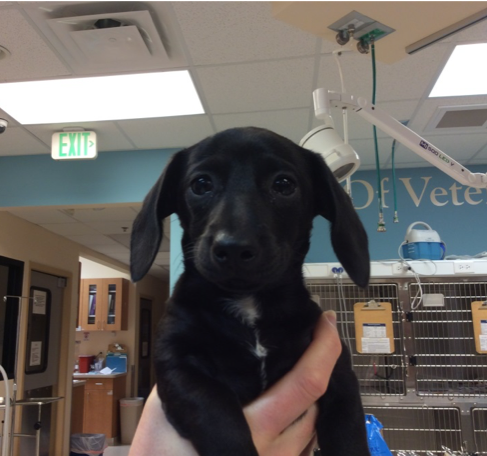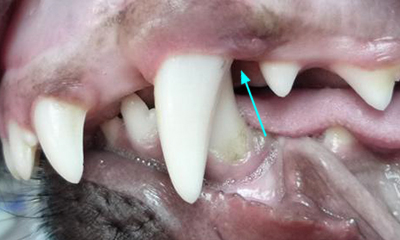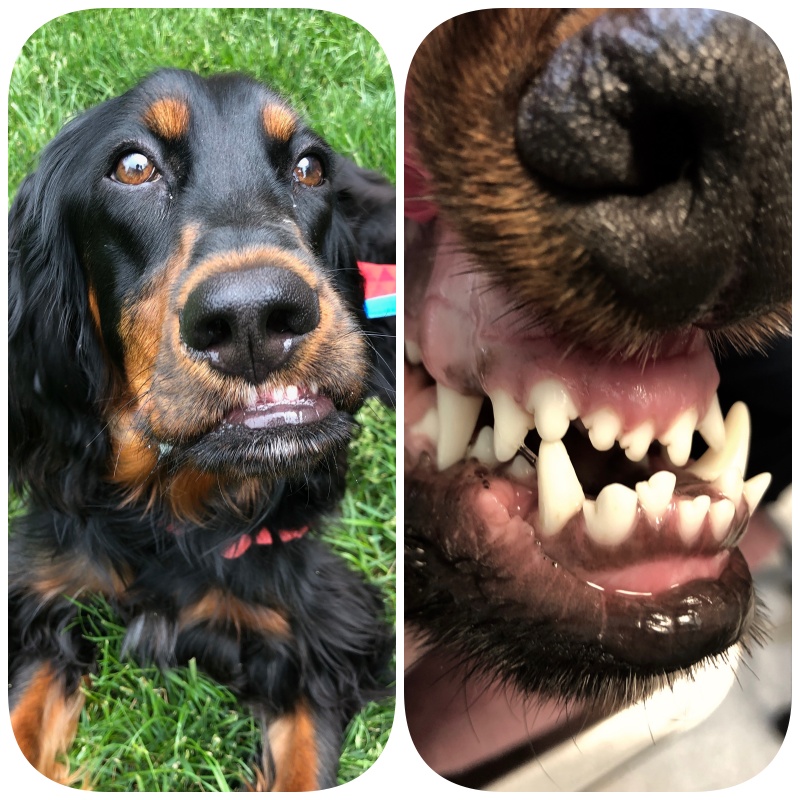class ii malocclusion dog
A dental malocclusion occurs when the upper and lower jaw lengths are considered normal but there may be one or more teeth that are out of normal. Class I Malocclusion Narrow Arches Edge-to-edge Anterior Occlusion Dental Crowding.
With a class 2 malocclusion in which the lower canines are penetrating the palatal mucosa this effectively staples the mandible to the maxilla s in that relationship an abnormal dental interlock.

. What are some common forms of skeletal malocclusion. Mandibular distoclusion Class 2 malocclusion. An underbite occurs when the mandibular lower jaw teeth protrude forward relative to the maxillary upper jaw teeth.
Leen Verhaert DVM Dip. Also known as an overbite overjet overshot and mandibular brachygnathism it occurs when the lower jaw is shorter relative to the length of the he upper jaw. Malocclusion can present without significant symptoms or can be severely debilitating.
This often results in mandibular canine teeth traumatizing the palate. Mandibular distoclusion or Class 2 Malocclusion MAL2. Interceptive orthodontic treatment may be elected to temporarily resolve painful contact points with the primary dentition.
Malocclusion results when the upper teeth do not align properly with the lower teeth. A Class II malocclusion is classified as the lower jaw mandible being too short in comparison with the upper jaw maxilla. This overbite can be caused by an overly prominent upper jaw or an underdeveloped lower jaw.
Normally the teeth interact in a manner that allows for powerful chewing and tearing of food. Incisors canines premolars and molars. The American Veterinary Dental College defines Class II malocclusion as mandibular distocclusion when there is an abnormal rostro-caudal relationship between the dental arches in which the mandibular arch occludes caudal to its normal position relative to the maxillary arch Figure 3.
Malocclusion means misalignment. In the dog the ideal tooth positions in the arches are defined by the occlusal interarch and interdental relationships of the teeth of the archetypal dog ie wolf. Class II malocclusions are considered overbites in dogs and cats.
Though any dog or cat may suffer from dental malocclusion this is considered a very common disorder in the world of purebred dogs. Orthodontia the movement of teeth is not performed on show dogs or dogs that are intended for breeding. Class II malocclusions with asymmetry or severe mandibular deficiency.
Terms that have commonly been associated with class II. Class III malocclusions are considered underbites in dogs and cats. You May Also Like Revisiting the world of canine raw diets.
The mandible is short with respect to its normal position with the maxilla. Class II Malocclusion Distocclusion Mandibular Brachygnathism Mandibular Retrusion--Overshot The mandible is too short relative to the maxilla. Progressive deformity is associ-ated with mechanical limitations on growth and the resulting condition is referred to as functional 336 SPECIAL REPORT -- ETIOLOGY OF CLASS II.
Class II malocclusion. However the adult dentition must be monitored closely and treated to achieve a lif. Class II Malocclusion.
Class II Division 2 Malocclusion Deep Overbite Canine Rotations Dental Crowding Case Galleries Class II Bite Jump. Another malocclusion that may be amenable to ball therapy is a mild Class 2 malocclusion. Class 2 malocclusions can be subdivided into two categories division 1 and division 2.
Malocclusion in dogs is commonly diagnosed in puppies when the primary dentition is present. Malocclusion - rotation of right upper canine 104. Class 2 or class II malocclusions are characterized by upper molars that are too far forward compared to the lower molars.
Treatment options vary for each type of malocclusion. The majority of malocclusion cases result. Skeletal malocclusion results when an abnormal jaw length creates a malalignment of the teeth.
In order to detect a malocclusion it is important for veterinary surgeons and veterinary nurses. Class II malocclusion is considered the most frequent problem presenting in the orthodontic practice affecting 37 of school children in Europe and occurring in 33 of all orthodontic patients in the USA. Our goal in these cases is to give our patients a comfortable and functional bite.
Orthodontic presentation is possible but class II overjet III underjet and linguoversed mandibular canines are the most common presentations. This is a type II malocclusion in a dog- the lower jaw is shorter than the upper jaw by about 1 inch. Abnormal jaw growth or misalignment of the teeth themselves can result in teeth that do not align in the correct fashion.
It can be classified as rostral or caudal. Lingually displaced 404 canine. Malocclusions are common in certain breeds of dogs.
Mandibular distoclusion Class 2 malocclusion. Orthodontic presentation is possible but class II overjet III underjet and linguoversed mandibular canines are the most common presentations. The mandible resides distal caudal to its normal location in relation to the maxilla Photo 5.
In this type of malocclusion the mandible and the maxilla are of equal lengths but one or more teeth are misaligned. Class II malocclusion 02. A malocclusion in which a mandibular tooth or teeth have a more buccal or labial position than the antagonist maxillary tooth.
The rest of the post is available to users registered at. In rostral crossbite cases similar to anterior crossbite in people one or more of the mandibular incisor teeth are labial to the opposing maxillary incisor teeth when the. Figure 2a One major difference between adult and deciduous malocclusions is the anatomy of the teeth involved.
Ball therapy is a treatment for mild malocclusions when the mandibular canines are impinging on the soft tissues of the upper jaw. Types of class 2 malocclusion. Malocclusion in dogs is usually hereditary which means the condition is passed down to future generations.
Some of the various treatment options include extraction of the offending tooth or teeth removing the crown of a tooth and performing. This happens when the maxilla is longer than the mandible. The amount of space between the maxillary and the mandibular incisors varies with the severity of the condition.
This often results in mandibular canine teeth traumatizing the palate. For example class 3 malocclusions underbites are commonly seen. Depending on the class of malocclusion palatinegingivalliptooth trauma can occur.
Even the lower incisors can be a problem as they can get hung up behind the palatal rugae and incisive papilla. Malocclusion in dogs and cats Peter Southerden Tuesday May 2 2017 Malocclusion involves abnormal relationships of teeth to each other and other oral structures. The mandible resides distal caudal to its normal location in relation to the maxilla Photo 5.
Therefore the mandibular incisors do not touch the cingulum of the maxillary incisors. There are two types of malocclusion. The mandibles are longer in respect to their normal relationship to the maxilla.
Maxillary Canine Tooth Extraction for Class 2 Malocclusion in a Dog. Dogs have four types of teeth.

Puppy Teeth Problems The Ultimate Guide Sydney Pet Dentistry

Canine Classification A Class I Canine With The Maxillary Canine Download Scientific Diagram

Angle S Classification For Malocclusions Dentalnotebook
Helping Your Puppy With Teeth Misalignment Malocclusions

Maxillary Canine Tooth Extraction For Class 2 Malocclusion In A Dog Semantic Scholar

Class Ii Malocclusions When The Lower Jaw Is Shorter Than The Upper Jaw The Cove

Malocclusion In Dogs And Cats The Veterinary Nurse

Defining Dental Malocclusions In Dogs

Treatment Of Class Ii Malocclusion With Tooth Movement Through The Maxillary Sinus American Journal Of Orthodontics And Dentofacial Orthopedics

That Bites Dental Malocclusions And Abnormal Bites In Pets Vet In Aurora The Animal Dental Clinic

Overbite Veterinary Dental Center Malocclusion In Pet

Malocclusions In Dogs And Cats Centennial Animal Hospital

Read This Dentistry Article By Katie Rankin Bs Rvt

Malocclusions In Dogs And Cats Centennial Animal Hospital

Malocclusion In Dogs And Cats The Veterinary Nurse

Malocclusions Misaligned Teeth Animal Dental Specialist

Feature Oral Health Issues In The Dog Developmental Abnormalities Malocclusions By David E Hansen Dvm Favd Davdc
